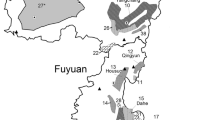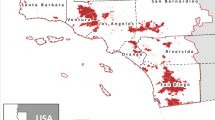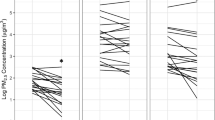Abstract
Communities impacted by fine-particle air pollution (particles with an aerodynamic diameter less than 2.5 μm; PM2.5) from forest fires and residential wood burning require effective, evidence-based exposure-reduction strategies. Public health recommendations during smoke episodes typically include advising community members to remain indoors and the use of air cleaners, yet little information is available on the effectiveness of these measures. Our study attempted to address the following objectives: to measure indoor infiltration factor (Finf) of PM2.5 from forest fires/wood smoke, to determine the effectiveness of high-efficiency particulate air (HEPA) filter air cleaners in reducing indoor PM2.5, and to analyze the home determinants of Finf and air cleaner effectiveness (ACE). We collected indoor/outdoor 1-min PM2.5 averages and 48-h outdoor PM2.5 filter samples for 21 winter and 17 summer homes impacted by wood burning and forest fire smoke, respectively, during 2004–2005. A portable HEPA filter air cleaner was operated indoors with the filter removed for one of two sampling days. Particle Finf and ACE were calculated for each home using a recursive model. We found mean Finf±SD was 0.27±0.18 and 0.61±0.27 in winter (n=19) and summer (n=13), respectively, for days when HEPA filters were not used. Lower Finf±SD values of 0.10±0.08 and 0.19±0.20 were found on corresponding days when HEPA filters were in place. Mean±SD ACE ([Finf without filter–Finf with filter]/Finf without filter) in winter and summer were 55±38% and 65±35%, respectively. Number of windows and season predicted Finf (P<0.001). No significant predictors of ACE were identified. Our findings show that remaining indoors combined with use of air cleaner can effectively reduce PM2.5 exposure during forest fires and residential wood burning.
This is a preview of subscription content, access via your institution
Access options
Subscribe to this journal
Receive 6 print issues and online access
$259.00 per year
only $43.17 per issue
Buy this article
- Purchase on Springer Link
- Instant access to full article PDF
Prices may be subject to local taxes which are calculated during checkout


Similar content being viewed by others
Abbreviations
- a 1 :
-
coefficient representing penetration of outdoor particles
- a2:
-
coefficient representing decay of indoor particles
- ACE:
-
air cleaner efficiency
- F inf :
-
infiltration factor
- HEPA:
-
high-efficiency particulate air
- pDR:
-
personal DataRAM
- PM2.5:
-
particles with an aerodynamic diameter less than 2.5 μm
- RH:
-
relative humidity
References
Abt E ., Suh H.H., Catalano P., and Koutrakis P. Relative contribution of outdoor and indoor particle sources to indoor concentrations. Environ Sci Tech 2000: 34: 3579–3587.
Aditama T.Y. Impact of haze from forest fire to respiratory health: Indonesian experience. Respirology 2000: 5: 169–174.
Allen R., Larson T., Sheppard L., Wallace L., and Lui L.-J.S. Use of real-time light scattering data to estimate the contribution of infiltrated and indoor-generated particles to indoor air. Environ Sci Tech 2003: 37: 3484–3492.
British Columbia Lung Association. BC state of the air report, 2006. Accessed at http://www.bc.lung.ca/pdf/bcstate_of_the_air_report2006.pdf January 15 2007.
Chan W.R., Nazaroff W.W., Price P.N., Sohn M.D., and Gadgil A.J. Analyzing a database of residential air leakage in the United States. Atmos Environ 2005: 39: 3445–3455.
Duclos P., Sanderson L.M., and Lipsett M. The 1987 forest fire disaster in California: assessment of emergency room visits. Arch Environ Health 1990: 45: 53–58.
Emmanuel S.C. Impact to lung health of haze from forest fires: the Singapore experience. Respirology 2000: 5: 175–182.
Environment Canada. Main emission sources, particulate matter, 2006. Accessed at http://www.ec.gc.ca/cleanair-airpur/Main_Emission_Sources-WS9A24D6D1-1_En.html September 19 2006.
Fischer G., and Schrattenholzer L. Global bioenergy potentials through 2050. Biomass Bioenergy 2001: 20: 151–159.
Flannigan M.D., Stocks B.J., and Wotton B.M. Climate change and forest fires. Sci Total Environ 2000: 262: 221–229.
Henderson D.E., Milford J.B., and Miller S.L. Prescribed burns and wildfires in Colorado: impacts of mitigation measures on indoor air particulate matter. J Air Waste Manag Assoc 2005: 55: 1516–1526.
Houck J.E., Tiegs P.E., McCrillis R.C., Keithley C., and Crouch J. Air emissions from residential heating: the wood heating option put into environmental perspective. Proceedings of US EPA and Air and Waste Management Association Conference: Emission Inventory: Living in a Global Environment, New Orleans, LA. December, 1998 Air and Waste Management Association, Pittsburgh, PA, 1998: 1: 373–384.
Koenig J.Q., Larson T.V., Hanley Q.S., Rebolledo V., Dumler K., Checkoway H., et al. Pulmonary function changes in children associated with fine particulate matter. Environ Res 1993: 63: 26–38.
Kunzli N., Avol E., Wu J., Gauderman W.J., Rappaport E., and Millstein J. Health effects of the 2003 southern California wildfire on children. Am J Respir Crit Care Med 2006: 174: 1221–1228.
Lai A.C. Particle deposition indoors: a review. Indoor Air 2002: 12: 211–214.
Larson T.V., and Koenig J.Q. Wood smoke: emissions and non-cancer respiratory effects. Annu Rev Public Health 1994: 15: 133–156.
Long C.M., Suh H.H., Catalano P.J., and Koutrakis P. Using time- and size-resolved particulate data to quantify indoor penetration and deposition behavior. Environ Sci Tech 2001: 35: 2089–2099.
Moore D., Copes R., Fisk R., Joy R., Chan K., and Brauer M. Population health effects of air quality changes due to forest fires in British Columbia in 2003: estimates from physician-visit billing data. Can J Public Health 2006: 97: 105–108.
Mott J.A., Meyer P., Mannino D., Redd S.C., Smith E.M., Gotway-Crawford C., et al. Wildland forest fire smoke: health effects and intervention evaluation, Hoopa, California, 1999. West J Med 2002: 176: 157–162.
Murray D.M., and Burmaster D.E. Residential air exchange rates in the United States: empirical and estimated parametric distributions by season and climatic region. Risk Anal 1995: 15: 459–465.
Naeher L.P., Brauer M., Lipsett M., Zelikoff J.T., Simpson C.D., Koenig J.Q., et al. Woodsmoke health effects: a review. Inhalation Toxicol 2007: 19: 67–106.
Nolte C.G., Schauer J.J., Cass G.R., and Simoneit B.R. Highly polar organic compounds present in wood smoke and in the ambient atmosphere. Environ Sci Tech 2001: 35: 1912–1919.
Norris G., Larson T., Koenig J., Claiborn C., Sheppard L., and Finn D. Asthma aggravation, combustion, and stagnant air. Thorax 2000: 55: 466–470.
Norris G., YoungPong S.N., Koenig J.Q., Larson T.V., Sheppard L., and Stout J.W. An association between fine particles and asthma emergency department visits for children in Seattle. Environ Health Perspect 1999: 107: 489–493.
Office of Air and Radiation. United States Environmental Protection Agency, 2006. Residential air cleaning devices: a summary of available information. Accessed at http://www.epa.gov/iaq/pubs/residair.html#standard%20for%20portables November 04 2006.
Pandian M.D., Behar J.V., Ott W.R., Wallace L.A., Wilson A.L., Colome S.D., and Koontz M.D. Correcting errors in the nationwide data base of residential air exchange rates. J Exp Anal Environ Epidemiol 1998: 8: 577–586.
Peters A., Dockery D.W., Muller J.E., and Mittleman M.A. Increased particulate air pollution and the triggering of myocardial infarction. Circulation 2001: 103: 2810–2815.
Quintana P.J., Samimi B.S., Kleinman M.T., Liu L.J., Soto K., Warner G.Y., et al. Evaluation of a real-time passive personal particle monitor in fixed site residential indoor and ambient measurements. J Expo Anal Environ Epidemiol 2000: 10: 437–445.
Rittmaster R., Adamowicz W.L., Amiro B., and Pelletier R.T. Economic analysis of health effects from forest fires. Can J For Res 2006: 36: 868–877.
Sapkota A., Symons J.M., Kleissl J., Wang L., Parlange M.B., and Ondov J. Impact of the 2002 Canadian forest fires on particulate matter air quality in Baltimore city. Environ Sci Tech 2005: 39: 24–32.
Simpson C.D., Dills R.L., Katz B.S., and Kalman D.A. Determination of levoglucosan in atmospheric fine particulate matter. J Air Waste Manag Assoc 2004: 54: 689–694.
Switzer P., and Ott W. Derivation of an indoor air averaging time model from the mass balance equation for the case of independent source inputs and fixed air exchange rates. J Exp Anal Environ Epidemiol 1992: 2 (suppl): S113–S135.
United States Environmental Protection Agency. How smoke from fires can affect your health, 2003. Accessed at http://depts.washington.edu/wildfire/resources/EPA2003.pdf June 23 2006.
Wallace L., and Williams R . Use of personal-indoor-outdoor sulfur concentrations to estimate the infiltration factor and outdoor exposure factor for individual homes and persons. Environ Sci Tech 2005: 39: 1707–1714.
Wu C.F., Delfino R.J., Floro J.N., Samimi B.S., Quintana P.J., Kleinman M.T., et al. Evaluation and quality control of personal nephelometers in indoor, outdoor and personal environments. J Exp Anal Environ Epidemiol 2005: 15: 99–110.
Wu C.H., Jimenez J., Claiborn C., Gould T., Simpson C.D., Larson T., Lui L.-J.S., et al. Agricultural burning smoke in eastern Washington: Part II. Exposure assessment. Atmos Environ 2006: 40: 5379–5392.
Zanobetti A., and Schwartz J. The effect of particulate air pollution on emergency admissions for myocardial infarction: a multi-city case-crossover analysis. Environ Health Perspect 2005: 113: 978–982.
Acknowledgements
We thank all study participants for their time, Tim Ma for performing laboratory analysis and Ryan Allen for assistance with data analysis.This study was supported by funding from the BC Ministry of Health with in-kind assistance from the UBC Centre for Health and Environment Research. All authors declare they have no competing financial interests.
Author information
Authors and Affiliations
Corresponding author
Rights and permissions
About this article
Cite this article
Barn, P., Larson, T., Noullett, M. et al. Infiltration of forest fire and residential wood smoke: an evaluation of air cleaner effectiveness. J Expo Sci Environ Epidemiol 18, 503–511 (2008). https://doi.org/10.1038/sj.jes.7500640
Received:
Accepted:
Published:
Issue Date:
DOI: https://doi.org/10.1038/sj.jes.7500640
Keywords
This article is cited by
-
Outdoor and indoor concentrations of size-resolved particulate matter during a wildfire episode in interior Alaska and the impact of ventilation
Air Quality, Atmosphere & Health (2022)
-
Infiltration of outdoor PM2.5 and influencing factors
Air Quality, Atmosphere & Health (2022)
-
Health effects of wildfire smoke in children and public health tools: a narrative review
Journal of Exposure Science & Environmental Epidemiology (2021)
-
Metal-organic frameworks with photocatalytic bactericidal activity for integrated air cleaning
Nature Communications (2019)
-
Efficacy of interventions targeting household air pollution from residential wood stoves
Journal of Exposure Science & Environmental Epidemiology (2017)



